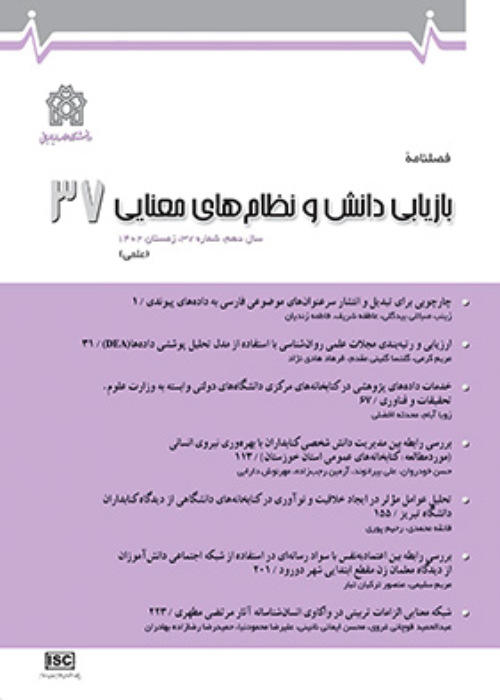Users' Perceptions and Interpretations of the Information Labels of the Website's User Interface: A Case Study of the Digital Library of the the National Library and Archives of Iran (NLAI)
Author(s):
Article Type:
Research/Original Article (دارای رتبه معتبر)
Abstract:
Awareness of users' perceptions and interpretations of the information labels of the user interface of digital library of the NLAI. The present study was an applied research with a mixed method. Data were collected through a researcher-made questionnaire, interview, and observation. Through a exploratory method, participants were asked to spend considerable time and in-depth to examine the categories, elements, and labels used in the digital library website and to determine their understanding of the website labels in the online questionnaire in the form of a Likert scale. Then, the semi-structured interview technique was used to study users' perceptions and interpretations of the labels assigned to the elements on the website. The study population included users of the digital library of the NLAI, which was selected in two groups of novice users (clients) and advanced users (librarians) of 20 people (10 novice users and 10 advanced users). In order to validate the research results, Methodological angulation was used to increase the reliability of the research data. During this method, the researcher used several methods to collect data (using interviews with observation, exploratory study, and questionnaire), as well as all research strategies and steps with the necessary documentation at the time of data collection were recorded. Finally, after collecting the data, the researcher used the Member checking method. During this quality control process, the researcher asked the 7 participants to read the notes and the results of the data and express their opinion on the accuracy of the findings. Cronbach's alpha test (0.85) was used to ensure the reliability of the data collection tool and the possible problems of the questionnaire. SPSS software was used to analyze the research data. Content analysis and Excel software were used to analyze the interview data. The results showed that the final average of comprehensibility of labels and terms used in the website is over 50% and indicates a good understanding of the terms and labels used in the website to represent information categories, but some labels need to be changed and updated. Some terms are not very understandable from the users' point of view and need to be revised, such as: "review", "quick look", "typical classification", "source registration", "legal considerations", "main site", "texts", "Periodical" and "Collection". The friendliness and user-friendliness of the words on the website, and the ban on the use of specialized, complex, and ambiguous words were among the demands of the users. New terms and labels were suggested by users. The use of specialized library terminology on the website, intangible and abstract words and lack of sufficient explanations about labels, lack of a comprehensive guide, going into more detail, complications on the website, and inconsistency in the use of words for similar concepts are some of the problems that cause the user does not have a good browsing experience.
Keywords:
Language:
Persian
Published:
Journal of Knowledge Retrieval and Semantic Systems, Volume:9 Issue: 33, 2023
Pages:
37 to 68
https://magiran.com/p2555740
دانلود و مطالعه متن این مقاله با یکی از روشهای زیر امکان پذیر است:
اشتراک شخصی
با عضویت و پرداخت آنلاین حق اشتراک یکساله به مبلغ 1,390,000ريال میتوانید 70 عنوان مطلب دانلود کنید!
اشتراک سازمانی
به کتابخانه دانشگاه یا محل کار خود پیشنهاد کنید تا اشتراک سازمانی این پایگاه را برای دسترسی نامحدود همه کاربران به متن مطالب تهیه نمایند!
توجه!
- حق عضویت دریافتی صرف حمایت از نشریات عضو و نگهداری، تکمیل و توسعه مگیران میشود.
- پرداخت حق اشتراک و دانلود مقالات اجازه بازنشر آن در سایر رسانههای چاپی و دیجیتال را به کاربر نمیدهد.
In order to view content subscription is required
Personal subscription
Subscribe magiran.com for 70 € euros via PayPal and download 70 articles during a year.
Organization subscription
Please contact us to subscribe your university or library for unlimited access!



